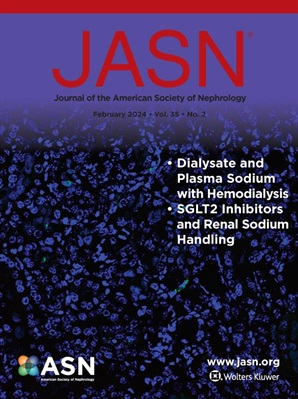荚膜细胞产生乙酰胆碱及其对肾小球肾炎肾损伤的保护作用
IF 10.3
1区 医学
Q1 UROLOGY & NEPHROLOGY
Journal of The American Society of Nephrology
Pub Date : 2024-09-20
DOI:10.1681/asn.0000000000000492
引用次数: 0
摘要
背景乙酰胆碱是调节血管内皮健康的最重要因素之一,虽然它与胆碱能神经递质有关,但它也在非神经元细胞中表达。为了确定肾脏中是否会产生乙酰胆碱,我们使用了 ChAT(BAC)-eGFP(ChAT 小鼠)转基因小鼠,在这种小鼠中,增强型绿色荧光蛋白(eGFP)在内源性胆碱乙酰转移酶(ChAT)转录调控元件的控制下表达。然后,我们通过在 ChAT 转基因小鼠中诱导抗肾小球基底膜肾小球肾炎(anti-GBM GN)来研究乙酰胆碱在肾脏疾病中的作用。结果我们证明,ChAT 是产生乙酰胆碱的唯一酶,它在肾小球荚膜细胞中表达并产生乙酰胆碱。我们还发现,在 ChAT 转基因小鼠抗 GBM GN 的过程中,ChAT 在肾小球(主要是荚膜细胞)中被诱导表达,并保护小鼠免受肾损伤,显著减少肾小球增生/纤维素坏死(71%)、新月体形成(98%)和肾小管损伤(78%)。相反,特异性敲除荚膜细胞 ChAT 会加重疾病的严重程度。保护机制包括减少炎症、减少血管生成因子和增加 eNOS 表达。体外和体内研究表明,胆碱酯酶抑制剂和 ChAT 诱导剂等可用药物可增加荚膜细胞 ChAT 的表达和乙酰胆碱的产生。本文章由计算机程序翻译,如有差异,请以英文原文为准。
Production of Acetylcholine by Podocytes and its Protection from Kidney Injury in Glomerulonephritis.
BACKGROUND
One of the most important factors modulating endothelial health is acetylcholine, and while it is associated as a cholinergic neurotransmitter; it is also expressed by non-neuronal cells. However, its role in the kidney, which does not receive cholinergic innervation, remains unknown.
METHODS
To determine if acetylcholine is produced in the kidney, we used ChAT(BAC)-eGFP (ChAT mice) transgenic mice in which enhanced green fluorescent protein (eGFP) is expressed under the control of the endogenous choline acetyltransferase (ChAT) transcriptional regulatory elements. We then investigated the role of acetylcholine in kidney disease by inducing anti- glomerular basement membrane glomerulonephritis (anti-GBM GN) in ChAT transgenic mice.
RESULTS
We demonstrate ChAT, the sole enzyme responsible for acetylcholine production, was expressed in glomerular podocytes and produced acetylcholine. We also show during anti-GBM GN in ChAT transgenic mice, ChAT expression was induced in the glomeruli, mainly in podocytes and protects mice from kidney injury with marked reduction of glomerular proliferation/fibrinoid necrosis (by 71%) crescent formation (by 98%), and tubular injury (by 78%). In contrast, specific knockout of podocyte ChAT worsened the severity of the disease. The mechanism of protection included reduction of inflammation, attenuation of angiogenic factors reduction, and increase of eNOS expression. In vitro and in vivo studies demonstrated available drugs like cholinesterase inhibitors and ChAT inducers increased the expression of podocyte-ChAT and acetylcholine production.
CONCLUSIONS
These findings suggest de novo synthesis of acetylcholine by podocytes protected against inflammation and glomerular endothelium damage in anti-GBM glomerulonephritis.
求助全文
通过发布文献求助,成功后即可免费获取论文全文。
去求助
来源期刊
CiteScore
22.40
自引率
2.90%
发文量
492
审稿时长
3-8 weeks
期刊介绍:
The Journal of the American Society of Nephrology (JASN) stands as the preeminent kidney journal globally, offering an exceptional synthesis of cutting-edge basic research, clinical epidemiology, meta-analysis, and relevant editorial content. Representing a comprehensive resource, JASN encompasses clinical research, editorials distilling key findings, perspectives, and timely reviews.
Editorials are skillfully crafted to elucidate the essential insights of the parent article, while JASN actively encourages the submission of Letters to the Editor discussing recently published articles. The reviews featured in JASN are consistently erudite and comprehensive, providing thorough coverage of respective fields. Since its inception in July 1990, JASN has been a monthly publication.
JASN publishes original research reports and editorial content across a spectrum of basic and clinical science relevant to the broad discipline of nephrology. Topics covered include renal cell biology, developmental biology of the kidney, genetics of kidney disease, cell and transport physiology, hemodynamics and vascular regulation, mechanisms of blood pressure regulation, renal immunology, kidney pathology, pathophysiology of kidney diseases, nephrolithiasis, clinical nephrology (including dialysis and transplantation), and hypertension. Furthermore, articles addressing healthcare policy and care delivery issues relevant to nephrology are warmly welcomed.

 求助内容:
求助内容: 应助结果提醒方式:
应助结果提醒方式:


